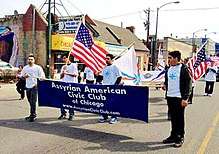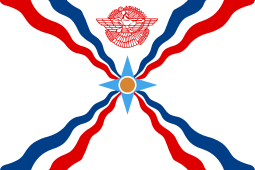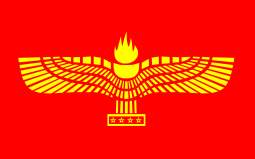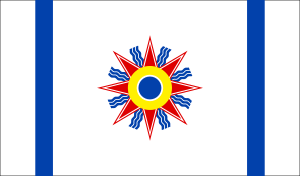Assyrian Americans
Assyrian Americans (Syriac: ܣܘܼܪ̈ܲܝܸܐ ܕܐܲܡܸܪܝܼܟܲܐ) refers to people born in or residing in the United States of Assyrian origin.
 Assyrian Americans carrying the Assyrian flag at the annual Kha b-Nisan parade in Chicago | |
| Total population | |
|---|---|
| 110,807-600,000[1][2][3][4] | |
| Regions with significant populations | |
| Michigan, California and Illinois | |
| Languages | |
| Neo-Aramaic · English | |
| Religion | |
| Christianity (majority: Syriac Christianity; minority: Protestantism) |
The largest Assyrian/Chaldean/Syriac diaspora is located in Metropolitan Detroit, with a figure of 150,000.[5] High concentrations are also located in Chicago, Phoenix, San Jose, Modesto, San Diego, Los Angeles, and Turlock, among others.[6]
The first large wave of Assyrian immigration to the United States was due to the Assyrian genocide, which occurred 1914–1920.
History
Early History
Assyrians have been present in the United States since the late 19th century. The first recorded Assyrian in America was Zia Attala.[7] He reportedly immigrated to Philadelphia in 1889 and found work in the hotel industry.[8] Most early Assyrian immigrants, however, were young men sent by Western missionaries for religious training.[9]
Second wave of immigration
Following the turn of the century, Assyrian immigration to America mostly came to a halt due to the Immigration Act of 1924 which effectively cut off any legal immigration to the United States for Assyrians and other non Western European groups. The second large wave of immigration occurred in the 1960s and 70s, mainly from northern Iraq due to conflicts and persecution by the Baathist government of Iraq. Many Assyrians arrived during this period and took advantage of the ongoing White flight in Detroit.
As a result of the situation, Assyrians gained a monopoly over grocery stores and other small businesses, and in many cases used their finances and newfound wealth to benefit the Assyrian community there and take in Assyrian refugees from Iraq. More Assyrians arrived throughout the 80s and 90s for similar reasons, with newer residents moving out of Detroit into suburbs such as Royal Oak and Sterling Heights due to the Crack epidemic in Detroit, while others began to move to San Diego, establishing a new Assyrian community there.
In 2005, the first Assyrian school in the United States, the Assyrian American Christian School, opened in Tarzana, Los Angeles.
In Michigan

Assyrian immigration to the cities in Michigan began in the early 20th century. The cities in the state include, but are not limited to, Detroit, Southfield, Sterling Heights, Oak Park, Troy, West Bloomfield, Commerce, Walled Lake, Rochester Hills, Farmington Hills, Ferndale, Warren, Bloomfield Hills and Ann Arbor. More and more Assyrians, as they establish themselves financially, quickly move out of Detroit and into the other locations, including San Diego and cities in Arizona.
Before the 1970s, Assyrians came to the United States in search of greater economic opportunities. After the 1970s, many Assyrians fled for political freedom, especially after the rise of Saddam Hussein and, after the Persian Gulf War. Some were drawn by the economic opportunities they had seen successfully affect their family members who had already immigrated.
Less stringent immigration laws during the 1960s and 1970s facilitated increasing numbers, with the 1970s seeing the highest number of Assyrians coming to the United States. In 1962, the number of Assyrian owned grocery stores was 120, but grew to 278 in 1972. The main cause of this were the 1967 Detroit riots, after which Jewish grocery store owners left the area and left the opportunity open for Assyrians to take over. Often these Jews sold their old stores to Assyrians.[10]
Iraqi president Saddam Hussein donated hundreds of thousands of dollars to Chaldean Catholic churches in Detroit and received a key to the city in the 1980s on behalf of mayor Coleman Young, when the Baath regime was an ally of the United States government.[11]
Mostly all new Assyrian Chaldean Catholic immigrants and low-income senior citizens tend to reside in Detroit, in the 7 Mile Road between Woodward Avenue and John R Street. This area was officially named Chaldean Town in 1999.[12] There are eight Chaldean Catholic churches in Metropolitan Detroit, located in West Bloomfield, Troy (where there are two), Oak Park, Southfield, Warren, Sterling Heights and Detroit.
In California
After World War II, several Assyrian men who had been educated in Iraq by American Jesuits traveled to the United States. They were to teach Arabic to U.S. officers at the Army Language School who were going to be stationed in the Middle East. The men started the San Diego-area Chaldean Catholic community. Yasmeen S. Hanoosh, author of The Politics of Minority Chaldeans Between Iraq and America, wrote that the Chaldean Catholic Church in San Diego "continued to grow in relative isolation from the family-chain-migration based communities in and around Michigan."[13]
In Illinois
Rev. Peter Elia from Iran was the first priest of the Chaldean Catholic community in Chicago which originated in 1907. In 1912, the St. Ephrem Chaldean Parish of Chicago was formed by Rev. Warda Mirza, also from Iran. [14]
Geographic distribution
According to the 2011 American Community Survey 1-Year Estimates there are 110,807 Assyrian people in the United States.[3][4]
The 2000 U.S. Census counted 82,355 Assyrians/Chaldeans/Syriacs in the country, of whom most lived in Illinois. These 3 groups were listed as one category in the United States Census [15]
Michigan
There are 26,378 living in Michigan according to the 2000 United States Census.[16]
- Sterling Heights: 5,515
- West Bloomfield: 4,874
- Southfield: 3,684
- Warren: 2,625
- Farmington Hills 2,499
- Troy: 2,047
- Detroit 1,963
- Oak Park 1,864
- Madison Heights: 1,428
- Bloomfield 513
- Hazel Park: 512
- Shelby Township: 493
- Clinton Township: 225
California
There are 22,671 living in California according to the 2000 United States Census.[17]
- The state's largest Assyrian American communities are in the San Diego area.
- Elsewhere in the Central Valley and San Francisco Bay area: known for its several Assyrian Church of the East, Chaldean Catholic and Syriac Orthodox churches; Oakland and East Bay suburbs; and Santa Clara County such as San Jose.
- Other parts of Southern California, i.e. the Los Angeles area.
- Orange County
- Inland Empire, California (Riverside-San Bernardino counties)
- The Coachella and Imperial Valleys
Illinois
There are 34,685 Assyrians living in Illinois according to the 2000 United States Census.[18]
- Chicago: 7,121
- Niles: 3,410
- Skokie
- Lincolnwood
- Morton Grove
- Maine Park: 1,035
Culture
Media
Assyrian, Syrian, Syriac
The U.S. federal government took the word Syrian to mean Arabs from the Syrian Arab Republic and not as one of the terms to identify the ethnically distinct Assyrians, although the terms Syrian and Syriac are strongly accepted by mainstream majority academic opinion to be etymologically, historically and ethnically derivative of the earlier term Assyrian,[19][20] and historically meant Assyrian (see Etymology of Syria). In addition, the Syrian Arab Republic is home to many ethnicities, including Arabs, Assyrians, Armenians, Kurds, and Turcomans, and is thus not an exclusively Arab nation.
The Syriac Orthodox Church was previously known as the Syrian Orthodox Church until a Holy Synod in 2000 voted to change it to Syriac, thus distinguishing from the Arabs. Mor Cyril Aphrem Karim wrote a letter to the Syriacs in 2000 urging them to register in the census as Syriac with a C, and not Syrian with an N to distinguish the group. He also urged them not to register as the country of origin.[21]
Chaldean refers to ethnic Assyrians who are (traditionally) Roman Catholic, having split from the Assyrian Church between the 17th and 19th centuries.
On the U.S. census, there is a section for the Assyrian/Chaldean/Syriacs, which is listed separately from Syrian, Syrian being a subcategory for Arab.[22]
Notable people
- Andre Agassi, Armenian-Assyrian Tennis player
- Terrence Malick, film director, screenwriter and producer.
- Adam Benjamin, Jr., former politician and a United States Representative from Indiana's 1st congressional district
- Rosie Malek-Yonan, actress, author, director, public figure and activist
- Anna Eshoo, U.S. Representative for California's 18th congressional district
- Nineveh Dinha, former American television reporter and anchor for Fox 13
- Victor Kamber, labor union activist and political consultant in the United States
- Vincent Oshana, actor and comedian
- Narsai David, author, radio and television personality in the Bay Area
- Raad Ghantous, half-Assyrian, half-Lebanese Interior designer
- Scott Rumana, Assyrian-American Republican Party politician
- Yasmine Hanani, Assyrian American actress
- Jumana Hanna, imprisoned at the facility known as Al Kelab Al Sayba, or Loose Dogs, during the rule of Saddam Hussein
- Diane Pathieu, television anchor
- Janan Sawa, Assyrian musician
- Timz, Assyrian-American rapper
- Justin Meram, footballer
- Sargon Dadesho, campaigner, nationalist
- Michael Shabaz, Assyrian-American tennis player
- Beneil Dariush, Assyrian-American professional mixed martial artist
- Daniel Alaei, professional poker player
- John Batchelor, American author and host of The John Batchelor Show radio news magazine
- Bob Miner, former American businessman, co-founder of Oracle Corporation and the producer of Oracle's relational database management system.
- John Joseph (academic), Assyrian-American educator and historian
- Steven Beitashour, international soccer player
- John Nimrod, U.S. politician
- George Sada, former Iraqi Air Force commander and author
- Andrew David Urshan, evangelist and author
See also
References
- "HCR2006 - 542R - I Ver".
- "Assyrian Genocide Resolution Read in Arizona Assembly".
- Data Access and Dissemination Systems (DADS). "American FactFinder – Results". Archived from the original on 12 February 2020. Retrieved 18 February 2015.
- "Selected Population Profile in the United States : 2011 American Community Survey 1-Year Estimates". Factfinder2.census.gov. Archived from the original on 12 February 2020. Retrieved 20 October 2013.
- "Chaldean American History". Chaldean Community Foundation. Retrieved 20 May 2020.
- Heinrich; Heinrich (2007). Why Humans Cooperate: A Cultural and Evolutionary Explanation. Oxford University Press. pp. 81–82.
- "6: Migrating to a New Land". Center for Migration Studies Special Issues. 15: 63–74. 1999. doi:10.1111/j.2050-411X.1999.tb00189.x.
- Reimers, David (1 January 2005). Other Immigrants: The Global Origins of the American People. NYU Press. p. 207. ISBN 9780814775356.
zia attala.
- Ishaya, Arianne. "ASSYRIAN-AMERICANS A STUDY IN ETHNIC RECONSTRUCTION AND DISSOLUTION IN DIASPORA". www.nineveh.com. Retrieved 17 September 2014.
- Chafets, Ze'ev. Devils Night: and Other True Tales of Detroit. New York: Random House, 1990
- "March 31, 2003". Zindamagazine.com. Archived from the original on 18 October 2003. Retrieved 20 October 2013.
- Adrian Humphreys (2 September 2011). "U.S. police foil Canada-to-Iraq luxury-car scheme". National Post. Retrieved 4 October 2014.
- Hanoosh, p. 195.
- Shoumanov, Vasili. Assyrians in Chicago. Arcadia Publishing.
- "American FactFinder". Factfinder.census.gov. Archived from the original on 10 February 2020. Retrieved 2013-10-20.
- "Census 2000 Summary File 3 (SF 3) – Sample Data: Michigan". United States Census Bureau. December 2000. Archived from the original on 12 February 2020. Retrieved 21 December 2015.
- "Census 2000 Summary File 3 (SF 3) – Sample Data: California". United States Census Bureau. December 2000. Archived from the original on 12 February 2020. Retrieved 21 December 2015.
- "Census 2000 Summary File 3 (SF 3) – Sample Data: Illinois". United States Census Bureau. December 2000. Archived from the original on 10 February 2020. Retrieved 21 December 2015.
- The Encyclopedia Americana, International ed. (c1986) Danbury, Conn.: Grolier
- Frye, R. N. (October 1992). "Assyria and Syria: Synonyms" (PDF). Journal of Near Eastern Studies 51 (4): 281–285. doi:10.1086/373570.
- "Mor Cyril Aphrem Karim – Syriac Orthodox Church of Antioch". Syrianorthodoxchurch.org. Archived from the original on 28 November 2013. Retrieved 20 October 2013.
- "U.S. Census website". United States Census Bureau. Retrieved 20 October 2013.
Further reading
- Hanoosh, Yasmeen H. The Politics of Minority Chaldeans Between Iraq and America. ProQuest, 2008. ISBN 0549984755, 9780549984757.
- Henrich, Natalie and Joseph Henrich. Why Humans Cooperate : A Cultural and Evolutionary Explanation: A Cultural and Evolutionary Explanation. Oxford University Press, May 30, 2007. ISBN 0198041179, 9780198041177.
- Sengstock, Mary C., and Sanaa Taha Al Harahsheh. "Chaldean Americans." Gale Encyclopedia of Multicultural America, edited by Thomas Riggs, (3rd ed., vol. 1, Gale, 2014), pp. 441–452. online
- Sengstock, Mary C. Chaldean-Americans: Changing Conceptions of Ethnic Identity (Center for Migration Studies, 1999).
- Sengstock, Mary C. Chaldeans in Michigan (Michigan State University Press, 2005).


